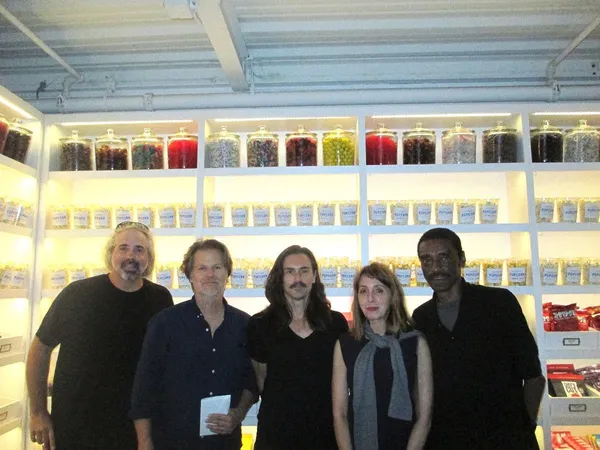 |
| Bob Edwards, Doug Nichol, Jeremy Mayer and Ken Alexander with Anne-Katrin Titze at the California Typewriter US theatrical premiere at Metrograph in New York Photo: John Benet |
Fritz Lang's Metropolis is seen as inspiration for sculptor Jeremy Mayer and John Mayer recalls a scene capturing his attention in DA Pennebaker's Don't Look Back, where Bob Dylan is using a typewriter, "sitting at the altar", to compose lyrics as Joan Baez sings and plays guitar as a turning point for him. Sam Shepard, "peripatetic" since he was an infant, feels that there is an "apparition taking place" when writing on his Hermes 3000.
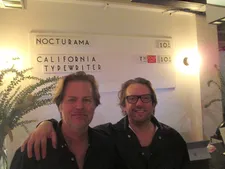 |
| Doug Nichol with producer John Benet at the sold-out opening night screening of California Typewriter Photo: Anne-Katrin Titze |
David McCullough and the drawings of the Brooklyn Bridge, Paul Auster and the magic in the keyboard, linking the machine to Tom Hanks and Martin Howard's fathers, typewriter poet Silvi Alcivar, John Mayer and a "Blade Runnery back alley deal", the mystery of QWERTY - Doug Nichol believes after making California Typewriter "that films have a life of their own."
In our conversation at Cafe Orlin on Saint Mark's Place the afternoon before the sold-out opening night screening and discussion at Metrograph, Doug Nichol guides us into the spellbinding realm where creativity can come from.
Anne-Katrin Titze: There's an exhibition at the Guggenheim at the moment on Mystical Symbolism and the Salon de la Rose + Croix in Paris (1892-1897). It's a magnificent exhibition.
Doug Nichol: There are people who find a certain magic in the keyboard. Even Paul Auster talks about how when he sits down to write he puts his fingers on the keyboard and he doesn't know - is the typewriter commanding the keys or is he commanding the keys? Is he like a puppet that's being held by the strings? So who is writing this? The machine or him? Whereas with the computer, it's all mysterious. You push a button and never know how things work. There is this kind of ouija board quality to a typewriter.
AKT: At the same time, it is something that you think you could understand, whereas nobody understands how the computer works. David McCullough says with a typewriter "you know you've made something - it's real."
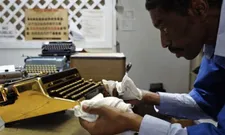 |
| California Typewriter's master repairman Ken Alexander |
DN: It's your work. You see it. I think a lot of people, even John Mayer finds that it's the fastest way to get ideas from here to here. Maybe it's misspelled and it's messy but then they can look at it and rewrite it. With a computer spell-check might change the words.
AKT: God, yes. We all know that. It's interesting that it's mostly men in your film.
DN: I don't know why that was. I tried to find women in the film and the only woman I found was Silvi [Alcivar], the poet. I don't know, I sometimes think that maybe women were secretaries for so long - all through the 20th century - that there's something in the DNA, rejecting it. I also think there's an interesting connection to fathers in the film, even though it doesn't come in.
Tom Hanks learned to type because his father told him to, you know, asked him to take a typing class. Martin Howard has this connection with his father. Many times, although it's not edited in the film, the machine is a reflection of the father.
AKT: It's strange about certain objects. I only know men who are fascinated by street signs. I don't know a single woman who would put one up on her wall. The last documentary where I noticed the lack of women commenting was Kent Jones's Hitchcock/Truffaut. Not for lack of trying, Kent said too.
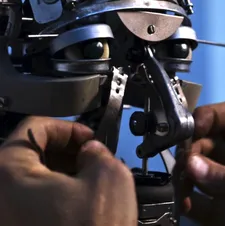 |
| Jeremy Mayer at work in California Typewriter |
DN: You know, what I believe after making this film is that films have a life of their own. And by making this one myself, I was able to really listen to what the film wanted to be. And I felt that I was more like a shepherd. The film had a direction it wanted to move in and I was just kind of guiding it there. The best things happened when I listened to what it wanted to be and I followed.
AKT: This morning, two hours ago, I had a conversation with Fernando Trueba about his film The Queen of Spain with Penelope Cruz. And we were talking about a previous conversation in which he mentioned how much he likes a quote by Picasso, namely that he "doesn't look for, he finds." Is that what you are talking about?
DN: I think that is the truth. I think that all artists - whether they're musicians or writers, painters, photographers - it's people who listen. I think it's fallacy that it just comes from inside your head. I think really good musicians, when they're writing a song - the song exists and they're hearing the song and bring it to life.
AKT: I like the comments about process that come up many times in your film. We don't know how things happen anymore. There won't be traces of the speeches of presidents. We don't see the editing, what has been crossed out and replaced.
DN: Yeah, you don't see the mistakes. David McCullough talked about that even when he did his book about the Brooklyn Bridge [The Great Bridge], he went back and he saw all the old drawings for the Brooklyn Bridge. There were many different designs and he could see the thought process of how it got to it. Today with computers, you often don't save those first drafts. So it's going to be very difficult for historians in the future to know a lot about us from our documents. Maybe through our Facebook pages - if those pages are still archived.
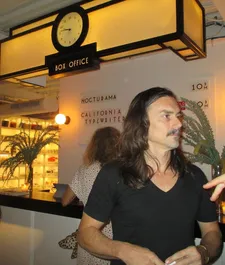 |
| Jeremy Mayer at the premiere of California Typewriter at Metrograph Photo: Anne-Katrin Titze |
AKT: Martin Howard says at one point that he would love to talk to Sholes and tell him that QWERTY is still used and bring him up to date. That reminded me of the ending of Buñuel's autobiography, My Last Sigh, where he says something along the lines of - I'm okay with dying, but I would like to come back to Earth, to the living, maybe once a year and buy a newspaper and read it.
DN: That's beautiful. And Sholes is really a forgotten person in history. Most people have no idea who he is. That's one of the little byproducts of this film - maybe a few more people will know about Christopher Latham Sholes. Because we still use his invention every day on our phones and our computers.
And it's a mystery why it's in that order. You know, one week it was ABCDEFG, all laid out like the alphabet. Then he went home for the weekend and he returned and it's QWERTY. There's no records, no notes on why. It's a total mystery. And we never changed it in 150 years.
AKT: I just talked about that with a neighbor on the train this morning. I told her about the theory from your film that all the letters on the top row spell the word typewriter.
DN: There's two theories. One, that it could spell out typewriter - they used that to sell. The other was that on the old typewriters the keys would jam if you hit like a T and an H together, they would stick. So they set them in a particular order to avoid the jamming of the keys. Still, there's no real record of that. It's nice that it's a mystery. And remains a mystery. I don't think we'll ever change it, because we're all so used to it.
AKT: John Mayer talks about finding typewriters in a "Blade Runnery back alley deal."
DN: He was just making a joke, you know, wherever you can find your typewriter, find one.
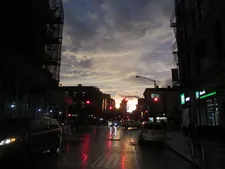 |
| Stormy night in New York before the event for California Typewriter at Metrograph Photo: Anne-Katrin Titze |
AKT: Typewriters do have a Blade Runnery past and present and future, I think.
DN: When I filmed John, he only had a Brother typewriter, which is an electronic one. After I filmed him, he and Tom [Hanks] met at a party. And Tom said:"No, no, no, you can't have a Brother. That's terrible! Let me send you a good typewriter."
AKT: One of his spare ones!
DN: So Tom sent him an Olympia, which is the best typewriter in the world. Since that time, John has been collecting Olympias. I think he has ten or so. Those are German typewriters. They're the best typewriters ever made.
AKT: And yours? The one you bought that started it all?
DN: It was an Underwood. You know it's very funny. The story why I bought it was I read in The New York Times about an artist who lived on the Lower East Side. And he's walking down Saint Mark's Place one morning and he found a typewriter on the street.
AKT: And here we are in a cafe on Saint Mark's Place.
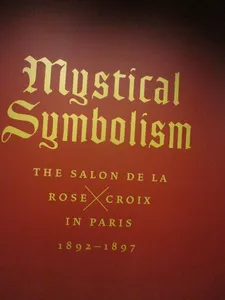 |
| Mystical Symbolism: The Salon de la Rose + Croix in Paris (1892-1897) at the Guggenheim Museum in New York Photo: Anne-Katrin Titze |
DN: Here we are. And he put it in his house and he said it's his favourite object that's on his desk. And I thought - I want to have a typewriter in my office. So I bought it for six dollars, sent to me on eBay. And then I fixed it up which led to the movie. So I started with the Underwood and then through the movie I needed to do shots of different typewriters. So I kept buying more typewriters. Now I have 85 typewriters. I'm going to sell them or give them away as gifts. And keep maybe my five favourite ones.
AKT: Did Martin Howard ever get his dream [of owning a Sholes & Glidden] fulfilled?
DN: For about 24 hours, he found a Sholes & Glidden and he bought it. But the keys weren't the original keys so then he re-sold it. So he is still searching.
Read what Doug Nichol had to say on the reenactment of Ed Ruscha and Mason Williams' Royal Road Test execution, the timeline for his film, the California Typewriter repair shop short leading to Tom Hanks, connecting to David McCullough, Sam Shepard at the Santa Fe Institute, and permanence, "about things lasting."
California Typewriter is in cinemas in the US.
Mystical Symbolism: The Salon de la Rose + Croix in Paris (1892-1897) at the Guggenheim Museum in New York is on display through October 4, 2017.





















